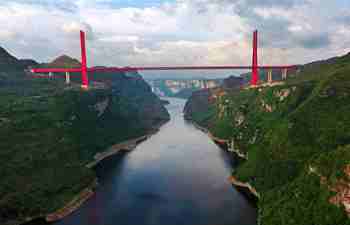By Xinhua Writer Luan Xiang
BEIJING, May 8 (Xinhua) -- More than a decade has passed since the Chinese baiji dolphin, or Lipotes vexillifer, was declared "functionally extinct."
Yet a recent image of the long-missing "Goddess of the Yangtze" has sparked hope for its reappearance as Asia's longest river recovers its ecological vitality.
IS THAT YOU, MISSING "GODDESS"?
Though the dolphin was believed by many to have gone extinct in the wild, some environmental scientists have never stopped believing that, somewhere along the vast drainage of the world's third longest river, a few remaining members of the rare species may be fighting for survival, far away from human activity.
Earlier this week, the China Biodiversity Conservation and Green Development Foundation (CBCGDF) released a photograph of a baiji lookalike, captured last month in a section of the Yangtze near Wuhu in the eastern province of Anhui.
Previous reports had been circulating about fishermen spotting a few of the blueish-gray mammals twice, both adults and young calves.
The foundation claimed that several researchers who have worked closely with the baiji or specialized in its study confirmed the image to be a surviving specimen of the species.
"Though the baiji is very likely to have gone extinct in the wild, the possibility remains that a few last surviving specimens could still be out there," said Wang Kexiong, professor with the Institute of Hydrobiology of the Chinese Academy of Sciences in Wuhan, in an interview with Xinhua.
The institute said it would be imprudent to identify the animal in a photograph without further evidence. Nonetheless, it is too soon to label the species "extinct."
The proof goes beyond just one image, said Su Fei, director of the CBCGDF's Baiji Program. For three years, the foundation has been organizing observation trips to raise protection awareness about the Yangtze's freshwater dolphins. In May 2017, several observers were confirmed to have witnessed the elegant mammal.
The baiji does not live in solitude, said Li Xinyuan, an investigator and baiji dolphin enthusiast who was present when the April image was taken, describing the moment of encounter as "extremely emotional."
"For two days straight, our teammates witnessed the baiji, but it was gone before they could press the shutter. On the third day, the photographer Jiao Shaowen decided to use a camera lens, rather than binoculars, to observe the water's surface, so he was able to take the shot the instant the baiji emerged," said Li, who led an ex-situ conservation project on the baiji in the 1980s.
He believes that if one was spotted, there could be a small school nearby.
"It is noticeable that the river's water quality and ecosystem have kept improving, thanks to state-led protection efforts," he said, stressing that hope prevails for the species to recover in number if environmental improvement continues.
WHAT NOW?
"To salvage the probable surviving baiji dolphins, emergency actions need to be taken with the country's best resources, talent and technology," said Hua Yuanyu, one of the pioneer scientists to survey the species back in the 80s.
"Waterborne transportation along the Yangtze ought to be properly managed to reduce the noise that has gravely affected the life of these sonar-guided dolphins," said the retired professor from Nanjing Normal University's Life Science Institute.
Meanwhile, destructive fishing methods such as high-voltage electrofishing, floating gill netting, and muro-ami, a technique that uses encircling nets with pounding devices, should be strictly forbidden, and any violation should be punished to protect both the dolphins and their prey, warned Hua.
"The baiji is a mammal that uses its lungs to breathe. If shocked by electricity, it may lose consciousness and drown," he said, criticizing the disastrous fishing practices as well as the discharge of waste into the waterway.
He called for enhanced law enforcement and wider education of local fishermen to turn them into protectors of the ecosystem.
"The protection of the Yangtze should include the water, the banks and the wetlands along its path, as the ecosystem is a whole," he said, and suggested the river dolphin's protection zone be extended to cover the habitat of the estimated last few baijis in Wuhu.
"I am optimistic that once the environment keeps improving, the baiji will come back," said Hua, inventor of a sonar orientation method that he and his team used to observe and deduce the size and distribution of the baiji population in 1986.
Back then, there were still nearly 300 of them living in 42 family-like schools along the Yangtze. Hua believes that these intelligent mammals have been hiding from human activity and river industries to survive quietly in some unexploited, serene waters.
The scholar praised the Chinese government's ambitious plan to protect the Yangtze ecosystem, predicting even better outcomes for the strategy.
NOT YET A FAREWELL
The baiji, scientific name Lipotes vexillifer, is a unique freshwater dolphin known to only inhabit the middle and lower reaches of the Yangtze river, where it had flourished for more than 20 million years, until industrialized fishing and a boom in transport in recent decades pushed the species to the edge of extinction.
In ancient times, the aquatic mammal was regarded as the goddess of protection for fishermen and boatmen along the 1,700-kilometer waterway from central China all the way to the Pacific.
Once described as "numerous," the last known living baiji died in captivity in 2002. After an international expedition in late 2006 failed to find any continued proof of its existence, the species was declared "functionally extinct" the following year.
On the IUCN's Red List of Threatened Species, the baiji dolphin was marked as "critically endangered, possibly extinct."
In the absence of the "goddess," China has been making vigorous efforts in restoring the ecosystem of the Yangtze. Building an ecological civilization was even written into the Constitution as a national development objective.
As a result, scientific surveys have confirmed an increasing number of the Yangtze finless porpoise, another of the river's mammal residents.
The reappearance of the baiji is another piece of evidence of the improved Yangtze ecology, said Hua.
Professor Wang Kexiong with the institute of hydrobiology said that there is still a long way to go for the protection and restoration of the Yangtze's natural habitats of species such as the finless porpoise.
"But the current development strategy has been adjusted toward the correct direction," he said.
"Monitoring, protecting, revitalizing and restoring the Yangtze's ecology and natural habitats should be our main tasks for the next 50 years," he said.
















